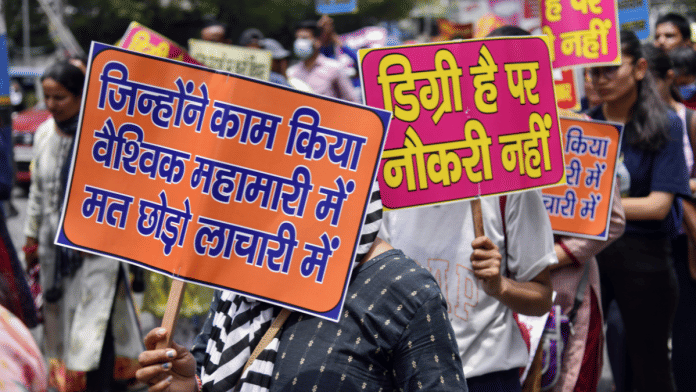India’s growth story is shadowed by a structural weakness: insufficient jobs. The paradox is stark — GDP growth remains high by global standards, yet employment creation lags. The result is a generation of educated, skilled Indians unable to find meaningful work. This is not a marginal imbalance but a systemic fault line that could turn the promise of a demographic dividend into long-term distress.
The annual Periodic Labour Force Survey (PLFS) report 2023-24 highlights the scale of the crisis. Urban youth unemployment among those aged 15-29 is 15.7 per cent — nearly one in six young urban Indians without work. The overall unemployment rate, 3.2 per cent, is unchanged from the previous year. Economists caution that these figures understate reality, since PLFS counts anyone who worked even an hour in a week as “employed”. This masks the extent of underemployment and the proliferation of insecure, gig-based livelihoods.
Rural India faces a slower but equally grim crisis. The average farm household earns about Rs 13,000 a month, making smallholder farming increasingly unviable. Even before the pandemic, incomes among the poorest households were declining — a trend that has only deepened. Rising demand for MGNREGA work, repeated farmer protests, and steady migration to cities all testify to this fragility. The figure of over 11,000 suicides in the farm sector in 2022 is a chilling reminder that this crisis is measured not only in statistics but in lives lost. What rural India needs urgently is a generation of decent non-farm jobs.
Also Read: Where is Skill India money going? It’s a Rs 48,000 crore mystery
Quality of jobs
Equally troubling is the quality of employment being created. A large share of new jobs is informal, low-paid, and devoid of social protection. Millions remain without contracts or stability, even as headline growth suggests expansion. Female labour force participation has improved in the last seven years, according to official data, but critics note that this largely driven by “unpaid and low-productivity work”.
Multiple schemes exist to promote textiles, tourism, food processing, and storage — sectors with the potential to create jobs at scale. Subsidies and incentives have been rolled out, yet outcomes remain limited. The issue lies less in intent and more in execution. Entrepreneurs still have to navigate layers of approvals, endless NOCs, and multiple offices. Business failures are often treated as quasi-criminal offences, discouraging risk-taking. Competition authorities have failed to check monopolistic practices, allowing a few dominant groups to crowd out smaller players. Excessive regulation in both manufacturing and services only adds to the burden. Taxation can be oppressive.
As a result, incentives do not translate into jobs at scale. Capital remains underutilised, enterprises stay small, and labour-intensive industries remain trapped below their potential. Deregulation — freeing entrepreneurs from unnecessary controls while strengthening competition law — must be central to any serious Jobs Mission. A strong Competition Commission, empowered to curb market concentration, would do more for job creation than another round of subsidies. Rajasthan’s MSME Facilitation and Development Act, 2019, which removed the need for pre-establishment approvals under any state law, is a model worth replicating nationally.
Also Read: India’s real jobs problem is not unemployment. It’s the lack of quality employment
Need for a National Jobs Mission
The current emphasis on skilling, though important, cannot substitute for employment creation. Training millions of young people without commensurate opportunities risks producing not more employed youth, but more skilled unemployed. What India needs is a National Jobs Mission — a coherent framework to expand labour-intensive employment, strengthen rural livelihoods, and prepare the workforce for technological transformation.
Such a mission must move simultaneously on three fronts.
First, targeted support for labour-intensive industries must be matched by deregulation. Removing barriers, simplifying compliance, and ensuring fair competition are the keys to unlocking sectors such as textiles, garments, food processing, construction, and tourism. These sectors have vast potential to absorb labour if allowed to flourish.
Second, rural infrastructure must be harnessed both as a means of development and for job creation. Investments in irrigation, rural roads, storage, schools, and health centres can generate large-scale employment in the short term while boosting productivity in the long run. Coordinated and timely delivery will be critical, requiring mechanisms that break down departmental silos.
Third, technology — especially artificial intelligence — must be integrated into employment strategy. India needs AI-trained personnel at the systems level: technicians, data specialists, designers, and engineers. But it is equally essential to democratise AI skills at the operating level across growth industries. Whether in agriculture, logistics, textiles, healthcare, or construction, workers must be trained to use AI-enabled tools. Only then can AI become an employment multiplier rather than a source of exclusion.
Financing such a Jobs Mission will require fiscal innovation. Progressive tax reform is essential — broadening the direct tax base, rationalising indirect taxes, and plugging leakages. Direct income and wage support to the poorest households, while job creation scales up, should be seen not as handouts but as investments in demand and social stability.
India today stands at a crossroads. High growth has not delivered high employment. Skilling programmes, though well-intentioned, will achieve little unless matched by a bold, coordinated Jobs Mission. Deregulation, rural job creation, and technological integration are not optional; they are imperative. Only with such an approach can India convert its demographic promise into inclusive prosperity, ensuring that growth translates into livelihoods for millions.
The author is a former finance secretary of the Government of India, a policy advisor and teaches public policy. He is also chairman of the Institute of Development Studies, Jaipur. Views are personal.
(Edited by Asavari Singh)







India will get only freebies, subsidies, reservations, and loan waivers.